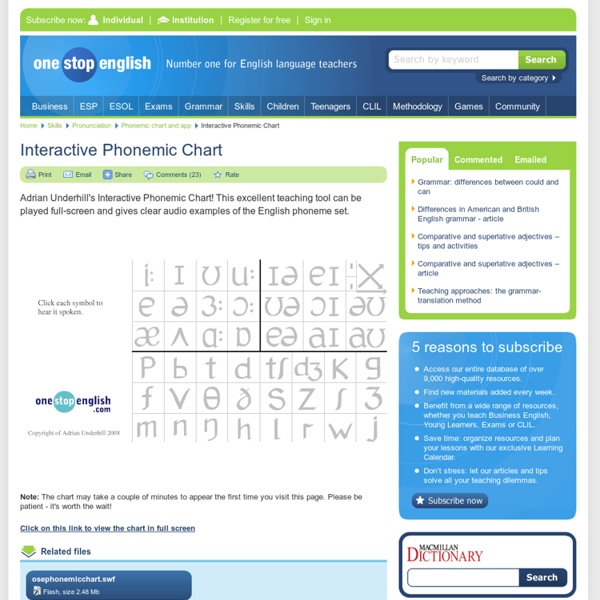



How to Teach Old Ears New Tricks “Hi! I'm Gabe. What's your name?” IPA Typewriter If the title above does not display correctly, you should click on "About" to find out how to get a unicode font. Introduction You can use this tool to type phonemic symbols to be inserted in a word processor. You can also use it to produce the code needed to insert phonemic symbols in a web page. To start work, use the buttons below to choose which you want to do. Use the "About" button to get more information about using phonetic symbols in word documents and web pages.
ESL Listening Comprehension Exercises: Movie clips to practice English SECTION 1: Movie Clips Learning through media (movies, music, etc.) is one of the best ways to learn a new language. The exercises below use movie clips to help you to better understand spoken English. Interactive Phonemic chart by Adrian Underhill - Macmillan English Interactive Phonemic ChartCreated by Adrian UnderhillThis excellent teaching tool gives audio examples of the English phoneme set. Click on the phonemes to hear the sound and a sample word. Find out more about how the chart works and how it can help you in the classroom in a series of exclusive videos with Adrian dedicated to teaching pronunciation skills.Adrian Underhill is the series editor for the Macmillan Books for Teachers and author of Sounds Foundations, the inspiration behind the award-winning Sounds: Pronunciation App.
Pronunciation Teaching: 11 quick multi-sensory techniques - Evolutions In this post I’d like to start a list/discussion of useful pronunciation teaching techniques. One of my favorite teachers-who-write, over at The Other Things Matter, inspired by another one at The Breathy Vowel, tweeted the following: Inspired by @breathyvowel tomorrow I start my weekly pron class. #SteppingOutofMyComfortZone — Kevin Stein (@kevchanwow) April 25, 2013 Podcasts I believe that podcasts (done properly) are a great way to learn English. One of my favourite podcasts was EnglishPod and I was disappointed when it went offline a few months ago. The good news is that it's back in a revamped form. 10 English jokes to make learning English fun. Laughter is the best medicine Jokes are an essential part of any language and culture and are a great way of understanding the target language through the play on words and a culture’s sense of humour. The English Language is filled with witty, clever jokes that illustrate the play on words such as homophones, double entendre and puns like this: Did you hear about the guy whose whole left side was cut off? He’s all right now. Every evening I share a joke on my Facebook Page under the title of Evening Fun.
Feel the beat: how rhythm shapes the way we use and understand language Do you feel the rhythm? Or a French rythme, Spanish ritmo, Swedish rytm, Russian ритм (ritm) or Japanese rizumu? Is there a difference? Linkers and connectors - English Subject Area Contrast . In spite of / Despite Link two contrasting ideas. Followed by a noun phrase.
IPA transcription systems for English John Wells, University College London1. Introduction: the IPA. 2. Pronunciations in dictionaries. 3. Consonants. 4. Stress. 5. Contact Us - Spanish Amigos Contact Us Telephone: 01932 883457 E-Mail: info@spanishamigos.co.uk Alternatively fill out our form: